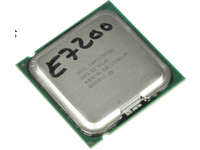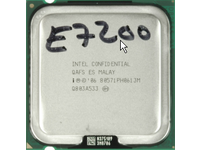G31 And E7200: The Real Low-Power Story
Core 2 Duo E7200
Intel’s Core 2 Duo processor was launched in late summer of 2006, and it arrived with a bang. All of a sudden, AMD’s Athlon 64 X2 processors were outclassed by a product that delivered better performance while simultaneously requiring less energy. Launched at a 2.66 GHz clock speed (2.93 GHz for the unaffordable Extreme edition), it held its superior standing for more than two years.
The first update was a bus speed bump that took the processors from FSB1066 to FSB1333 in the summer of 2007 with the launch of the P35 platform and slightly modified processors. The second modification was FSB1600 speed in the high end and shrinking the process from 65 nm to 45 nm. All of the Core 2 Duo E7000, E8000 processors and Core 2 Quad Q8000 and Q9000 are based on the 45 nm Wolfdale cores. Yorkfield, which is the core name for the quad core, utilizes two Wolfdale die.
Core 2 Duo E7000
Over time, Wolfdale received some improvements, the latest being the introduction of the M0 stepping, which continues to reduce processor power in idle states when compared to the L steppings. We looked around for a reasonable processor that utilized the latest stepping and we found the Core 2 Duo E7200, which utilizes only 3 MB L2 cache instead of 6 MB cache. Undoubtedly, the reduced L2 cache capacity represents another power saving opportunity, of which we wanted to take advantage.
The E7000-series currently consists of only two models: the E7300 at 2.66 GHz and the E7200 at 2.53 GHz. Both are based on the Wolfdale core, but again have only 3 MB L2 cache and a reduced front side bus speed of FSB1066—this is in contrast to the FSB1333 used for all Core 2 Duo E8000 models (which have 6 MB L2 cache). The E7000 series does not support virtualization technology (VT) nor Trusted Execution technology (TXT)—this isn’t an issue for our purposes, since both are insignificant for mainstream desktop users. A smaller L2 cache capacity together with relaxed clock speeds makes this processor an excellent choice for a high efficiency computer as you’ll see in the benchmark section. Despite being rated at the default TDP of 65 W for desktop processors, the Core 2 Duo E7200 stays pretty far away from that limit.
Get Tom's Hardware's best news and in-depth reviews, straight to your inbox.

